





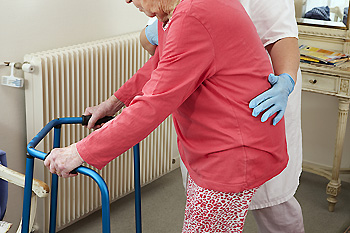 Falling is a common fear many of us are born with. When adults fall it can induce damage to the body, and the feet are often affected. Research has indicated many people over the age of sixty-five fall, and it is helpful to implement preventive methods into their living environment. These can include removing frayed rugs and improving lighting in the household. Additionally, it is beneficial to install grab bars in the shower and toilet area, and many patients find it useful to use a bathmat. It is important to have regular physical and eye examinations, where current medication can also be monitored. Many patients perform frequent stretching and exercise routines as this is often a key factor that can help to ensure strong bodies. If you would like more information about preventing falls and how falling can affect the feet, please consult with a podiatrist.
Falling is a common fear many of us are born with. When adults fall it can induce damage to the body, and the feet are often affected. Research has indicated many people over the age of sixty-five fall, and it is helpful to implement preventive methods into their living environment. These can include removing frayed rugs and improving lighting in the household. Additionally, it is beneficial to install grab bars in the shower and toilet area, and many patients find it useful to use a bathmat. It is important to have regular physical and eye examinations, where current medication can also be monitored. Many patients perform frequent stretching and exercise routines as this is often a key factor that can help to ensure strong bodies. If you would like more information about preventing falls and how falling can affect the feet, please consult with a podiatrist.
Preventing falls among the elderly is very important. If you are older and have fallen or fear that you are prone to falling, consult with one of our podiatrists from Active Foot and Ankle Care, LLC. Our doctors will assess your condition and provide you with quality advice and care.
Every 11 seconds, an elderly American is being treated in an emergency room for a fall related injury. Falls are the leading cause of head and hip injuries for those 65 and older. Due to decreases in strength, balance, senses, and lack of awareness, elderly persons are very susceptible to falling. Thankfully, there are a number of things older persons can do to prevent falls.
How to Prevent Falls
Some effective methods that older persons can do to prevent falls include:
Falling can be a traumatic and embarrassing experience for elderly persons; this can make them less willing to leave the house, and less willing to talk to someone about their fears of falling. Doing such things, however, will increase the likelihood of tripping or losing one’s balance. Knowing the causes of falling and how to prevent them is the best way to mitigate the risk of serious injury.
If you have any questions, please feel free to contact our offices located in Fair Lawn, Riverdale, and Englewood, NJ . We offer the newest diagnostic and treatment technologies for all your foot care needs.
Blisters often occur on the feet due to friction from shoes or socks rubbing against a part of the foot while you walk. Fortunately, blisters usually don’t require any special care and typically go away on their own. If you see a blister on your foot, protect it by covering it with a loosely wrapped bandage or cushioning it with an adhesive bandage. This will help prevent the blister from popping, which can be painful and expose the raw skin underneath the blister to infection. While usually not serious, foot blisters do sometimes require medical care. If your blister is showing signs of infection or becoming more painful over time, or if you are prone to getting blisters over and over again, please seek the care of a podiatrist.
Blisters are prone to making everyday activities extremely uncomfortable. If your feet are hurting, contact one of our podiatrists of Active Foot and Ankle Care, LLC. Our doctors can provide the care you need to keep you pain-free and on your feet.
Foot Blisters
Foot blisters develop as a result of constantly wearing tight or ill-fitting footwear. This happens due to the constant rubbing from the shoe, which can often lead to pain.
What Are Foot Blisters?
A foot blister is a small fluid-filled pocket that forms on the upper-most layer of the skin. Blisters are filled with clear fluid and can lead to blood drainage or pus if the area becomes infected.
How Do Blisters Form?
Blisters on the feet are often the result of constant friction of skin and material, usually by shoe rubbing. Walking in sandals, boots, or shoes that don’t fit properly for long periods of time can result in a blister. Having consistent foot moisture and humidity can easily lead to blister formation.
Prevention & Treatment
It is important to properly care for the affected area in order to prevent infection and ease the pain. Do not lance the blister and use a Band-Aid to provide pain relief. Also, be sure to keep your feet dry and wear proper fitting shoes. If you see blood or pus in a blister, seek assistance from a podiatrist.
If you have any questions, please feel free to contact our offices located in Fair Lawn, Riverdale, and Englewood, NJ . We offer the newest diagnostic and treatment technologies for all your foot care needs.
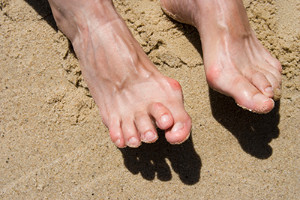 When the second toe bends up at the middle joint, it may be indicative of a condition that is known as hammertoe. This is considered to be a deformity, and can cause difficulty in walking. In severe cases, these deformed toes can resemble hammers, and may require surgery to permanently straighten the toes. Hammertoe can occur from genetic factors, or from wearing high heels, or tight shoes. Many times, these types of shoes do not provide adequate room for the toes to move freely in. Some patients find mild relief when specific toe stretches are performed, and custom made insoles are worn. If surgery is performed, it can take several weeks for a full recovery, and a special shoe may need to be worn. If you suffer from hammertoe, please speak with a podiatrist when the first symptoms appear, so a proper diagnosis can be made and treatment can be started.
When the second toe bends up at the middle joint, it may be indicative of a condition that is known as hammertoe. This is considered to be a deformity, and can cause difficulty in walking. In severe cases, these deformed toes can resemble hammers, and may require surgery to permanently straighten the toes. Hammertoe can occur from genetic factors, or from wearing high heels, or tight shoes. Many times, these types of shoes do not provide adequate room for the toes to move freely in. Some patients find mild relief when specific toe stretches are performed, and custom made insoles are worn. If surgery is performed, it can take several weeks for a full recovery, and a special shoe may need to be worn. If you suffer from hammertoe, please speak with a podiatrist when the first symptoms appear, so a proper diagnosis can be made and treatment can be started.
Hammertoes can be a painful condition to live with. For more information, contact one of our podiatrists of Active Foot and Ankle Care, LLC. Our doctors will answer any of your foot- and ankle-related questions.
Hammertoe
Hammertoe is a foot deformity that occurs due to an imbalance in the muscles, tendons, or ligaments that normally hold the toe straight. It can be caused by the type of shoes you wear, your foot structure, trauma, and certain disease processes.
Symptoms
Risk Factors
Treatment
If you have hammertoe, you should change into a more comfortable shoe that provides enough room for your toes. Exercises such as picking up marbles may strengthen and stretch your toe muscles. Nevertheless, it is important to seek assistance from a podiatrist in order to determine the severity of your hammertoe and see which treatment option will work best for you.
If you have any questions, please feel free to contact our offices located in Fair Lawn, Riverdale, and Englewood, NJ . We offer the newest diagnostic and treatment technologies for all your foot care needs.
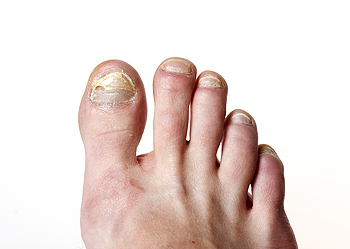 Research has indicated that millions of people worldwide are affected by toenail fungus. It is an unsightly condition that typically begins with symptoms showing in the big toe. These can include a change in nail texture and color, in addition to becoming thick, brittle, and gradually crumble. It is caused by a fungus that lives and thrives in warm and moist environments, consisting of public swimming pools, shower room floors, and surrounding areas. It is considered to be contagious, and can enter the body through tiny cracks in the skin on the feet. Treatment can begin with changing the socks and shoes daily, and properly trimming the toenails. If you are afflicted with toenail fungus, it is strongly advised that you are under the care of a podiatrist who can guide you toward the correct treatment technique.
Research has indicated that millions of people worldwide are affected by toenail fungus. It is an unsightly condition that typically begins with symptoms showing in the big toe. These can include a change in nail texture and color, in addition to becoming thick, brittle, and gradually crumble. It is caused by a fungus that lives and thrives in warm and moist environments, consisting of public swimming pools, shower room floors, and surrounding areas. It is considered to be contagious, and can enter the body through tiny cracks in the skin on the feet. Treatment can begin with changing the socks and shoes daily, and properly trimming the toenails. If you are afflicted with toenail fungus, it is strongly advised that you are under the care of a podiatrist who can guide you toward the correct treatment technique.
For more information about treatment, contact one of our podiatrists of Active Foot and Ankle Care, LLC. Our doctors can provide the care you need to keep you pain-free and on your feet.
Toenail Fungus Treatment
Toenail fungus is a condition that affects many people and can be especially hard to get rid of. Fortunately, there are several methods to go about treating and avoiding it.
Antifungals & Deterrence
Oral antifungal medicine has been shown to be effective in many cases. It is important to consult with a podiatrist to determine the proper regiment for you, or potentially explore other options.
Applying foot powder on the feet and shoes helps keep the feet free of moisture and sweat.
Sandals or open toed shoes – Wearing these will allow air movement and help keep feet dry. They also expose your feet to light, which fungus cannot tolerate. Socks with moisture wicking material also help as well.
If you have any questions please feel free to contact our offices located in Fair Lawn, Riverdale, and Englewood, NJ . We offer the newest diagnostic tools and technology to treat your foot and ankle needs.
 Many babies are born with flat feet. There are patients who have no symptoms of flat feet as daily activities are easily accomplished. If the condition is severe, surgery may be a necessary remedy for permanent relief. Some of the symptoms that can be associated with this condition often include pain and discomfort in the heel and arch area and the foot may appear to be swollen. There is a procedure known as arthrodesis that involves fusing the bones in the foot together. This can be helpful in reducing severe pain and discomfort. Another form of surgery is performed by placing a wedge on the center of the foot. If you are afflicted with flat feet and have any pain associated, please consult with a podiatrist to learn the various treatment options that may be right for you.
Many babies are born with flat feet. There are patients who have no symptoms of flat feet as daily activities are easily accomplished. If the condition is severe, surgery may be a necessary remedy for permanent relief. Some of the symptoms that can be associated with this condition often include pain and discomfort in the heel and arch area and the foot may appear to be swollen. There is a procedure known as arthrodesis that involves fusing the bones in the foot together. This can be helpful in reducing severe pain and discomfort. Another form of surgery is performed by placing a wedge on the center of the foot. If you are afflicted with flat feet and have any pain associated, please consult with a podiatrist to learn the various treatment options that may be right for you.
Foot surgery is sometimes necessary to treat a foot ailment. To learn more, contact one of our podiatrists of Active Foot and Ankle Care, LLC. Our doctors will assist you with all of your foot and ankle needs.
When Is Surgery Necessary?
Foot and ankle surgery is generally reserved for cases in which less invasive, conservative procedures have failed to alleviate the problem. Some of the cases in which surgery may be necessary include:
What Types of Surgery Are There?
The type of surgery you receive will depend on the nature of the problem you have. Some of the possible surgeries include:
Benefits of Surgery
Although surgery is usually a last resort, it can provide more complete pain relief compared to non-surgical methods and may allow you to finally resume full activity.
Surgical techniques have also become increasingly sophisticated. Techniques like endoscopic surgery allow for smaller incisions and faster recovery times.
If you have any questions please feel free to contact our offices located in Fair Lawn, Riverdale, and Englewood, NJ . We offer the newest diagnostic and treatment technologies for all your foot and ankle needs.
By monitoring a child’s foot development in the early years—and intervening if any structural abnormalities or dysfunction is present—the child’s quality of life can be vastly improved, and serious foot complications later in life may be avoided. Some milestones in a child’s early development are: sitting up by themselves at approximately 6-7 months, beginning to walk at roughly 12 months, and walking heel-to-toe by age 3 instead of on their toes as some toddlers do while learning to walk. Toe walking after age 3 may just be a habit, or due to a tight Achilles tendon, or it could possibly be an indicator of a muscular, neurological, or developmental issue the child may have. If you are concerned about your child’s foot development, schedule an appointment with a podiatrist for a full examination and consultation.
The health of a child’s feet is vital to their overall well-being. If you have any questions regarding foot health, contact one of our podiatrists of Active Foot and Ankle Care, LLC. Our doctors can provide the care you need to keep you pain-free and on your feet.
Tips for Keeping Children's Feet Healthy
If you have any questions, please feel free to contact our offices located in Fair Lawn, Riverdale, and Englewood, NJ . We offer the newest diagnostic and treatment technologies for all your foot care needs.
 Many women often feel the effects of their pregnancy in their feet. Sometimes the face, hands, and legs become swollen too, but most commonly the feet and ankles are affected, and all this swelling is known as edema. It is generally caused by the growing fetus in addition to the extra body fluids that often accompany pregnancy. Many women experience swollen feet and ankles in the second trimester, and this may continue to progress throughout the pregnancy. It can be beneficial to elevate the feet as frequently as possible, in addition to eating foods that have low sodium levels. Research has indicated it can help to limit the amount of time standing or walking and drinking 12 cups of water daily has been known to reduce a portion of the swelling. If you have questions about how pregnancy can affect the feet, please consult with a podiatrist.
Many women often feel the effects of their pregnancy in their feet. Sometimes the face, hands, and legs become swollen too, but most commonly the feet and ankles are affected, and all this swelling is known as edema. It is generally caused by the growing fetus in addition to the extra body fluids that often accompany pregnancy. Many women experience swollen feet and ankles in the second trimester, and this may continue to progress throughout the pregnancy. It can be beneficial to elevate the feet as frequently as possible, in addition to eating foods that have low sodium levels. Research has indicated it can help to limit the amount of time standing or walking and drinking 12 cups of water daily has been known to reduce a portion of the swelling. If you have questions about how pregnancy can affect the feet, please consult with a podiatrist.
Pregnant women with swollen feet can be treated with a variety of different methods that are readily available. For more information about other cures for swollen feet during pregnancy, consult with one of our podiatrists from Active Foot and Ankle Care, LLC. Our doctors will attend to all of your foot and ankle needs.
What Foot Problems Can Arise During Pregnancy?
One problem that can occur is overpronation, which occurs when the arch of the foot flattens and tends to roll inward. This can cause pain and discomfort in your heels while you’re walking or even just standing up, trying to support your baby.
Another problem is edema, or swelling in the extremities. This often affects the feet during pregnancy but tends to occur in the later stages.
How Can I Keep My Feet Healthy During Pregnancy?
If you have any questions please feel free to contact our offices located in Fair Lawn, Riverdale, and Englewood, NJ . We offer the newest diagnostic and treatment technologies for all your foot and ankle needs.
People who work all day on their feet can experience throbbing, painful feet at the end of a shift. Along with putting your feet up during work breaks and standing on a cushioned mat, a few simple exercises after hours may help to alleviate the swelling and ease pain. Take your shoes and socks off and sit in a chair. Put a tennis ball on the floor and, using the bottom of your foot, press down and roll it around. Do this for a few minutes and then switch feet. For pain specifically on the bottom of the foot, stand up and lift your leg behind you. Place your toes down behind you and lightly push, feeling the stretch on the bottom of your foot. Hold this position for 10 seconds and then repeat on the other foot. To stretch your ankles, lay on your back and point your toes up towards the ceiling. Alternately point and flex your toes 10 times, and then gently roll your ankles in circles. You can schedule an appointment with a podiatrist who can examine your feet and offer additional ways to support and protect your feet, and relieve any heel or ankle pain you may be experiencing.
While working on the feet, it is important to take the proper care of them. For more information about working on your feet, contact one of our podiatrists from Active Foot and Ankle Care, LLC. Our doctors will treat your foot and ankle needs.
Working on Your Feet
Standing on your feet for long periods of time can cause stress and pain in your feet. Your whole body may experience change in terms of posture, back pain, bunions, callouses and or plantar warts. There are ways to avoid these conditions with proper foot care, smart choices and correct posture.
Positive Changes
Negative heeled shoe – Choosing this shoe type places the heel slightly lower than the ball of the foot. These are great for overall foot health. Find shoes that fit you correctly.
Go barefoot – Our feet were not designed to be enclosed for all hours of the day. Try to periodically expose your feet to air.
Eliminate Pain
Foot Exercises – Performing simple exercises, incorporating yoga and doing stretches are beneficial. This will allow increased blood flow to the area and muscles of the foot.
Achilles tendon – Stretching the foot out flat on the floor will relax the calf muscles and tendon. These exercises can be performed almost anywhere. Make sure you add these exercises to your daily regimen.
With a little bit of this information and knowing more about foot health, you will notice changes. Foot stretches and proper footwear will help with pain and prevent further issues.
If you have any questions please feel free to contact our offices located in Fair Lawn, Riverdale, and Englewood, NJ . We offer the newest diagnostic and treatment technologies for all your foot and ankle needs.
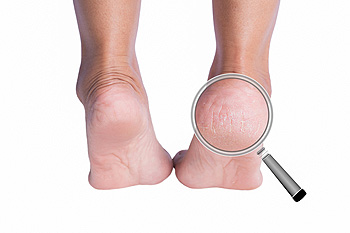 A common reason why the foot condition that is known as cracked heels can develop is due to thyroid disease. Additionally, it may happen from wearing shoes that have an open back, or from a vitamin deficiency. Patients who are overweight may experience cracked heels, which can cause severe pain and discomfort. Many people can find mild relief from having regular pedicures performed, as this is often helpful in keeping the skin as smooth as possible. Diabetic patients are often prone to developing cracked heels, which is why it is suggested that a podiatrist be contacted to offer proper management techniques.
A common reason why the foot condition that is known as cracked heels can develop is due to thyroid disease. Additionally, it may happen from wearing shoes that have an open back, or from a vitamin deficiency. Patients who are overweight may experience cracked heels, which can cause severe pain and discomfort. Many people can find mild relief from having regular pedicures performed, as this is often helpful in keeping the skin as smooth as possible. Diabetic patients are often prone to developing cracked heels, which is why it is suggested that a podiatrist be contacted to offer proper management techniques.
If the skin on your feet starts to crack, you may want to see a podiatrist to find treatment. If you have any concerns, contact one of our podiatrists from Active Foot and Ankle Care, LLC. Our doctors can provide the care you need to keep you pain-free and on your feet.
Cracked Heels
It is important to moisturize your cracked heels in order to prevent pain, bleeding, and infection. The reason cracked heels form is because the skin on the foot is too dry to support the immense pressure placed on them. When the foot expands, the dry skin on the foot begins to split.
Ways to Help Heal Them
Ways to Prevent Cracked Heels
If you are unsure how to proceed in treating cracked heels, seek guidance from a podiatrist. Your doctor will help you with any questions or information you may need.
If you have any questions, please feel free to contact our offices located in Fair Lawn, Riverdale, and Englewood, NJ . We offer the newest diagnostic and treatment technologies for all your foot care needs.
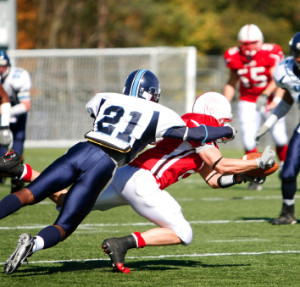 Turf toe is a very common sports injury, particularly among football players and soccer players. It occurs when the big toe joint is sprained because of a repetitive upward bending of the joint that often occurs from jamming the toe, or pushing off while jumping or running. Turf toe gets its name because it is especially common when playing on artificial turf, where the foot is more prone to sticking to the hard surface and becoming jammed. Turf toe is commonly indicated by pain, swelling, and limited joint movement in the big toe. Treatment generally consists of rest, ice, compression and elevation, but severe cases may require surgery. Athletes who are experiencing these symptoms should consult with a podiatrist for a proper diagnosis and treatment.
Turf toe is a very common sports injury, particularly among football players and soccer players. It occurs when the big toe joint is sprained because of a repetitive upward bending of the joint that often occurs from jamming the toe, or pushing off while jumping or running. Turf toe gets its name because it is especially common when playing on artificial turf, where the foot is more prone to sticking to the hard surface and becoming jammed. Turf toe is commonly indicated by pain, swelling, and limited joint movement in the big toe. Treatment generally consists of rest, ice, compression and elevation, but severe cases may require surgery. Athletes who are experiencing these symptoms should consult with a podiatrist for a proper diagnosis and treatment.
Ankle and foot injuries are common among athletes and in many sports. They can be caused by several problems and may be potentially serious. If you are feeling pain or think you were injured in a sporting event or when exercising, consult with one of our podiatrists from Active Foot and Ankle Care, LLC. Our doctors will assess your condition and provide you with quality foot and ankle treatment.
Common Injuries
The most common injuries that occur in sporting activities include:
Symptoms
Symptoms vary depending upon the injury and in some cases, there may be no symptoms at all. However, in most cases, some form of symptom is experienced. Pain, aching, burning, bruising, tenderness, tightness or stiffness, sensation loss, difficulty moving, and swelling are the most common symptoms.
Treatment
Just as symptoms vary depending upon the injury, so do treatment options. A common treatment method is known as the RICE method. This method involves rest, applying ice, compression and elevating the afflicted foot or ankle. If the injury appears to be more serious, surgery might be required, such as arthroscopic or reconstructive surgery. Lastly, rehabilitation or therapy might be needed to gain full functionality in the afflicted area. Any discomfort experienced by an athlete must be evaluated by a licensed, reputable medical professional.
If you have any questions, please feel free to contact our offices located in Fair Lawn, Riverdale, and Englewood, NJ . We offer the newest diagnostic and treatment technologies for all your foot care needs.
Diabetes can create a perfect storm of complications which sometimes leads to ulcers on the feet that go undetected and don’t heal. While the overwhelming majority of foot ulcers heal with proper foot care and treatment, a foot ulcer that does not heal may lead to infection, tissue necrosis (dead tissue), and—in severe cases—amputation. Diabetic limb salvage is a complex process involving a variety of procedures and techniques with the goal of preserving the limb as much as possible, and reducing the risks of future infections and ulcerations. If you have questions about diabetic foot conditions or would like to know more regarding limb salvage, it is highly suggested that you seek the counsel of a podiatrist.
Limb salvage can be an effective way in preventing the need for limb amputation. If you have diabetes, cancer, or any other condition that could lead to foot amputation if left unchecked, consult with one of our podiatrists from Active Foot and Ankle Care, LLC. Our doctors will assess your condition and provide you with quality foot and ankle treatment.
What Is Limb Salvage?
Limb salvage is the attempt of saving a limb, such as the foot from amputation. Podiatrists also try to make sure that there is enough function in the foot after the salvage that it is still usable. Diabetes is the number one cause of non-traumatic amputations in the United States. Those with diabetes experience poor blood circulation, which prevents proper healing of an ulcer. If the ulcer is left uncheck, it could become infected, which could result in the need for amputation.
However, there are other causes as well, such as cancer and traumatic injury. Links between higher mortality rates and amputation have been found. This translates into higher healthcare costs, and a reduced quality of life and mobility for amputees. Podiatrists have attempted to increase the prevalence of limb salvage in an attempt to solve these issues.
Diagnosis and Treatment
Limb salvage teams have grown in recent years that utilize a number of different treatments to save the infected limb. This includes podiatrists that specialize in wound care, rehabilitation, orthotics, and surgery. Through a combination of these methods, limb salvage has been found to be an effective treatment for infected limbs, and as an alternative to amputation. Podiatrists will first evaluate the potential for limb salvage and determine if the limb can be saved or must be amputated.
If you have any questions, please feel free to contact our offices located in Fair Lawn, Riverdale, and Englewood, NJ . We offer the newest diagnostic and treatment technologies for all your foot care needs.






